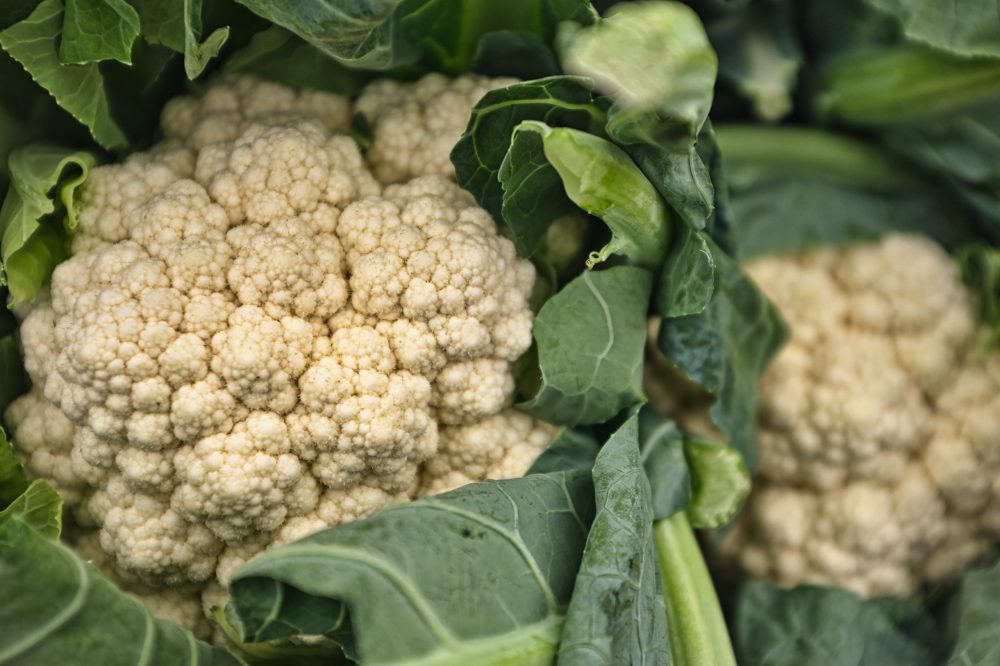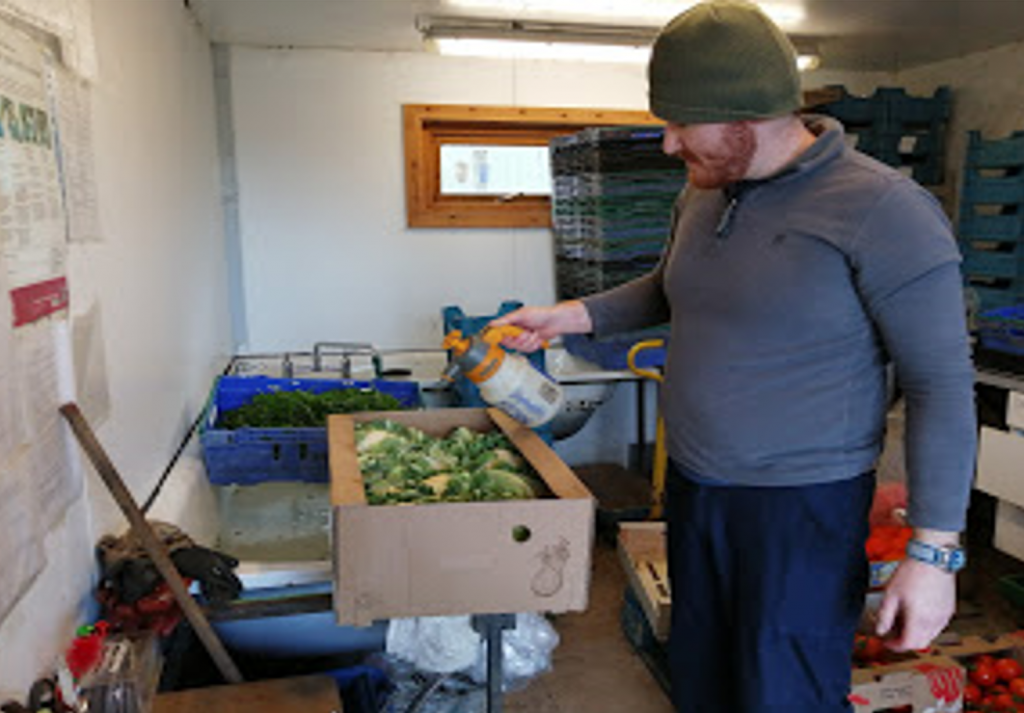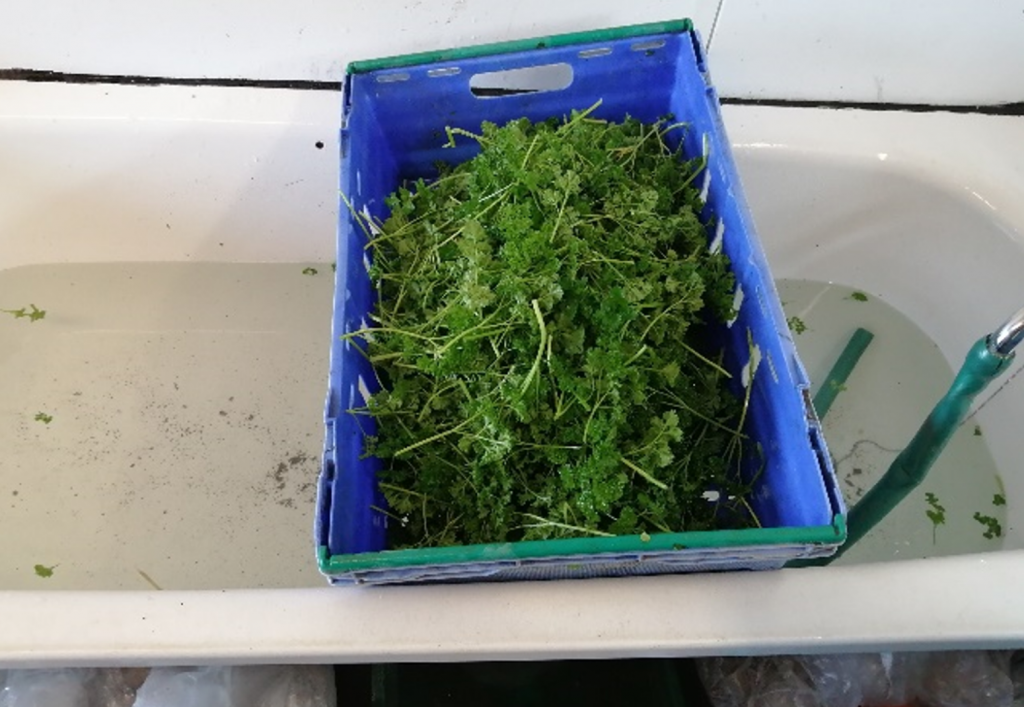
Over 2 million tonnes of fruit and vegetables are wasted between harvest and arrival at the retail outlet. Table 1 shows the most important causes of losses in some common crops
| GROUP | EXAMPLES | CAUSES OF LOSS |
| Root vegetables | Carrots
Beets Onions Garlic Potato |
Mechanical injuries |
| Improper curing | ||
| Sprouting and rooting | ||
| Water loss (shrivelling) | ||
| Decay | ||
| Chilling injury | ||
| Leafy vegetables | Lettuce
Chard Spinach Cabbage Spring onions |
Water loss (wilting) |
| Loss of green colour (yellowing) | ||
| Mechanical injuries | ||
| Relatively high respiration rates | ||
| Decay | ||
| Flower vegetables | Globe artichokes
Broccoli Cauliflower |
Mechanical injuries |
| Yellowing and other discolorations | ||
| Abscission of florets | ||
| Decay | ||
| Immature-fruit vegetables | Cucumbers
Squash Aubergines Peppers Snap peas/beans |
Over-maturity at harvest |
| Water loss (shrivelling) | ||
| Bruising and other mechanical injuries | ||
| Chilling injury | ||
| Decay | ||
| Bruising | ||
| Mature-fruit vegetables and fruits | Tomato
Melons Apples Stone fruits |
Over-ripeness and excessive softening at harvest |
| Water loss | ||
| Chilling injury (chilling sensitive fruits) | ||
| Compositional changes | ||
| Decay |
Table 1: Causes of losses in some common crops
From : Small Scale Postharvest Handling Practices: A Manual for Horticultural Crops (4th edition). July 2002, UC Davis.
This guide looks at the steps you can take during harvesting and storage to minimise those losses. The supply chain is a key factor. For example, losses tend to be highest for soft fruit because the shelf life is very short. For other crops over production can be a problem; a recent WRAP study with large scale tomato producers showed that mismatches between production and demand were by far the biggest contributor to waste for this crop.
Harvesting
Harvesting at the correct maturity
Timing harvest so the crop reaches the final customer in peak condition is very important but is different for individual crops, circumstances and supply chains. Table 2 shows some key indicators that determine when a range of crops are ready to harvest.
| Index | Examples |
| Elapsed days from full bloom to harvest | Apples, pears |
| Mean heat units during development | Peas, apples, sweet corn |
| Development of abscission layer | Some melons, apples |
| Surface morphology and structure | Cuticle formation on tomatoes
Netting of some melons Gloss of some fruits (development of wax) |
| Size | All fruits and many vegetables |
| Specific gravity | Cherries, potatoes |
| Shape | Compactness of broccoli and cauliflower |
| Solidity | Lettuce, cabbage, brussels sprouts |
| Firmness | Apples, pears, stone fruits |
| Tenderness | Peas, runner & French beans |
| External Colour | All fruits and most vegetables |
| Internal colour and structure | Formation of jelly-like material in tomatoes. Flesh colour of some fruits |
| Starch content | Apples, pears |
| Sugar content | Apples, pears, stone fruits |
| Internal ethylene concentration | Apples, pears |
Table 1: Harvest maturity indicators for some common crops
From: Small Scale Postharvest Handling Practices: A Manual for Horticultural Crops (4th edition). July 2002, UC Davis.
Avoiding or reducing damage
Damage at harvest is a significant contributor to losses.
- For mechanical harvesting, setting the machine up correctly is vital. For example, when harvesting root crops the blade must enter the soil at the right depth and angle to maximise the number of roots/ tubers lifted and minimise the number that are cut and damaged. Time spent optimising the setup is always time well spent.
- Bruising can be a major problem. When harvesting potatoes, carrots and other root crops, minimise the drop from the harvester into the box. Use chutes, sort pockets or other devices that break or cushion the fall of the root or tuber into the trailer/box/ bin
- Handle crops susceptible to damage, such as tomatoes and soft fruit with care. This can be difficult, because a high pick rate is important to reduce labour costs and to get perishable crops into store as quickly as possible to minimise deterioration. A good supply of skilled and trained labour is therefore central to reducing wastage.
- Remove any protruding nails or staples and smooth the rough edges on field containers.
- Minimise the need to transfer products from one container to another, and when it is necessary, take care when doing so
- Clean all debris out of all containers.
- Do not overfill containers. Severe damage can result from crushing when they are stacked.
Slowing down deterioration
Some very perishable crops, such a leafy salads and soft fruits begin to deteriorate the moment the harvested portion is removed.
- For these crops, time is of the essence and it is very important that the crop is taken off the field and into appropriate storage as soon as possible. Delays can be costly, and therefore ensuring smooth running of the harvesting operation is an important aspect of reducing waste. This might include: securing sufficient skilled labour; making sure there are enough crates/ bags available; having sufficient storage space; and ensuring good access between field and store.
- In summer, harvest at the coolest time of the day (usually early in the morning). If it necessary to leave harvested produce in the field for any length of time, it should be in the shade (erect a gazebo or similar if need be) and covered with damp towels.
Pre storage cooling
For very perishable crops, is vital to get the temperature down as fast as possible after harvest because, even though the harvested portion of the crop has been removed from the plant it is still living and respiring. It is vital to slow down the rate of respiration and therefore senescence by cooling.
- For some crops, exposing produce to cold air in an enclosed space is sufficient. ‘Forced-air cooling’ uses fans to circulate cool air and speeds up the cooling down process significantly. A gentle movement of air (2-4 mph) is all that is required. Barriers can be set up within the store to funnel air through the containers.
- For very perishable crops such as salads and some field crops ‘hydro cooling’ can significantly reduce waste. This is simply using water to remove heat, which it does about 15 times faster than air. There is a wide range of commercial hydro coolers on the market, but they are generally designed for large scale/ high through put systems and represent considerable investment. For smaller scale operations, a simple tank, or even a bath will suffice. Salad leaves can be effectively cooled after 30 – 45 minutes immersion, and then shaken dry. Whatever system is used it vital that the product is kept cool after emersion, and that the water you use is clean
| System | Suitable crops | Notes |
| Room Cooling | All vegetables | Too slow for very perishable crops. |
| Forced Air Cooling | Strawberry, Fruit-type Vegetables, Tubers, Cauliflower | Much faster than room cooling. Cooling rates very uniform |
| Hydrocooling | Stems, Leafy Vegetables, Some Fruit-type Vegetables | Very fast cooling; |
Adapted from: Vegetable Resources Chapter X: Harvesting and Handling, Alfred B. Wagner, Frank J. Dainello, and Jerry M. Parsons
Storage
Economics
While many growers perceive costs of storage to be high, it can also bring many benefits to the business, potentially improving profitability and resilience, for example:
- Being able to supply a much wider range of product over a longer period. This is particularly important for direct sales, such as box schemes, market stalls and Community Support Agriculture shares, where customers expect a reasonable diversity of produce throughout the year
- Investment in storage facilities allows a higher proportion of crops to be marketed as a result of better crop quality
- It may enable produce to be held back and sold at a time of year when prices are higher.
Capital investment grants, most recently the Food Business Investment Grant, are available to support the purchase of storage facilities.
Conditions
Ideal storage conditions for some key crops in Wales are summarised below. While they vary from crop to crop, in general terms temperatures of 0 – 2 oC and a relative humidity of 90 – 100% covers most crops. Important exceptions are cucumbers, tomatoes, potatoes, and summer squash which require high temperature but high humidity; and onions which prefer a lower temperature but lower humidity.
It is rare that growers have the capacity to have storage facilities at more than one or two conditions, and that maintaining stores at near 0oC is very expensive in terms of money, energy and carbon. As a result, many find that a cold store maintained at 3-5 oC and a RH of 85 – 95%, while not ideal, is an acceptable compromise.
| Crop | Temperature (oC) | Relative Humidity (%) | Storage time (Days) |
| Apple | 1 – 4 | 90 -95 | 30-180 |
| Asparagus | 0-2 | 95 – 100 | 14-21 |
| Beetroot | 0 | 98 – 100 | 120-180 |
| Broccoli | 0 | 95 – 100 | 14-21 |
| Brussel Sprouts | 0 | 95 – 100 | 21-35 |
| Cabbage | 0 | 98 – 100 | 150-180 |
| Carrot | 0 | 98 – 100 | 210-270 |
| Cauliflower | 0 | 98 – 100 | 21-28 |
| Celery | 0 | 97 – 99 | 30-90 |
| Celeriac | 0 | 97 – 99 | 180-240 |
| Cucumber | 10-13 | 95 | 10-14 |
| Fennel | 0 – 2 | 90 – 95 | 14-21 |
| Kohl Rabi | 0 | 98 – 100 | 60-90 |
| Leek | 0 | 95 – 100 | 60-90 |
| Lettuce | 0-2 | 98 – 100 | 14-21 |
| Onions(dry) | 0 | 65- 70 | 30-80 |
| Parsley | 0 | 95 – 100 | 30-60 |
| Plum | 0 | 90 – 95 | 14-35 |
| Potato | 5-13 | 90 – 95 | 150-300 |
| Radish | 0 | 95 – 100 | 21-28 |
| Raspberry | 0 | 90 – 95 | 2-3 |
| Spinach | 0 | 95 – 100 | 7-14 |
| Strawberry | 0 | 90 – 95 | 5-7 |
| Swiss Chard | 0 | 95 – 100 | 10-14 |
| Summer squash | 5-10 | 95 | 7-14 |
| Tomato | 8-10 | 90 – 95 | 8-10 |
| Water cress | 0 | 95 – 100 | 14-21 |
Ideal storage conditions for key crops (adapted from Manual for the preparation and sale of fruits and vegetables FAO)
Storage methods
There are many methods or storage, each with their pro and cons and costs and benefits. These are outlined below.
| System | Description | Pros | Cons | Notes |
| Field storage | Crops are left in the field until they are required | Simple
Low cost Better skin finish for some crops e.g. parsnips |
High risk of frost and pest & disease attack
Weather conditions may not permit harvest when the crops are required Planting of following crops may be delayed |
Not all soil types are suitable for field storage. Heavy soils such as clay are unsuitable as the crop may come in contact with water as soils may become waterlogged and produce will start rotting |
| Cellars | Stores located either below or partly below ground and therefore well insulated | Stable temperature (approx. 11°C), offering protection from extremes | Expensive to build if not already existing
Limited ventilation and expensive to retro fit Loading and unloading below ground can be difficult |
Existing cellars can provide opportunities to store small volumes of crops that do not require chilling, such as cabbages onions and potatoes |
| Clamps | Crops are stored in bulk, either loose or in boxes/ crates inside sheds. Walls of clamps are often built with straw bales for insulation. The top covered with a layer of insulation, usually of straw. | Low cost
Flexibility; the decision to build a clamp can be made at harvest time. Easy to construct from a technical point of view |
Construction involves high labour costs
Temperatures in unvented clamps can rise above 10ºC increasing risk of diseases Relatively high risk of frost and rodent damage Dehydration Difficult to monitor crop |
Most suitable for hard vegetables, such as potatoes, carrots, beetroot, turnips, swedes, celeriac and parsnips. |
| Cold storage | Refrigerated and insulated storeroom/ container | Controlled environment (temperature & relative humidity)
Crops can be stored under ideal conditions expending shelf life
|
Requires sufficient investment | Not all products are suitable for cold storage Some potatoes change taste; Onions that are cold stored have a higher risk of bolting; Cold stored carrots are more prone to splitting |
| Derived from: ‘Alternative methods of organic vegetable storage in Wales – Opportunities and Constraints’ Pauline van Diepen; and ‘Harvesting the Sun A Profile of World Horticulture, e international society for horticultural science
|
||||
Case study: Glebelands Market Garden, Cardigan
Glebelands Market Garden produces a wide range of organic fruit and vegetables on a 1 Ha site in St Dogmaels, near Cardigan. The produce in sold through a small farm shop, located on the site. Produce grown on site is supplemented by product bought in from local wholesalers to ensure that a wide range is available all year round.
Adam York, who jointly owns and runs the business with his partner, Lesley Bryson said ‘We harvest in cool conditions. In summer that means picking as early as possible in the morning and we harvest only what we think we will need until the next picking day. We have been running for 8 year now so can estimate fairly accurately how much of which products people buy throughout the year.”
Produce is harvested into plastic crates, in which they are washed ,if necessary, and carried into the pack house without delay. If crates need to be kept in the field for any length of time in hot conditions, heat susceptible crops such as leafy greens are covered by damp towels or newspaper to keep the temperature down and reduce water loss.
The leafy vegetables are put into a bath of cold, mains water to rapidly reduce the temperature. They remain there for a period of time depending on the ambient temperature; a few minutes in winter and 30 – 45 minutes in summer. They are then put back in the crates and shaken dry. Packed produce is placed immediately in LDPE bags. For product sold loose, the crate is put inside a large plastic bag (banana box linings are ideal) to retain moisture. All product is then transferred to the cold store as soon as possible.
Head crops (cabbages, broccoli etc) are also harvested into plastic crates. Once in the pack house they are put into boxes, spayed with a mister, the crates are put inside a plastic bag and placed immediately in cold shore.
Glebelands has only one cold store, which is maintained at temperature of 4.5 – 6.0 oC, and a relative humidity of about 75%. Adam said ‘Our losses between harvest and sale are very small. The main factor is having a rapid turnover in the shop and we only pick what we need to keep us going to the next harvest. That means we store as little as possible for a short a time as possible, so although our store conditions may not be perfect for every crop, they are perfectly adequate for the period of time we need.

Misting cauliflowers prior to storage to minimise water loss |

Draining after hydro cooling |
Resources
- Alliums: Leeks storage and harvesting. Horticulture Network Wales
- Calabrese: Disease resistance Horticulture Network Wales
- Minimizing damage, AHDB Potatoes https://potatoes.ahdb.org.uk/sites/default/files/publication_upload/Damage%20Brochure%20131121%20Low%20Resolution.pdf
- Organic Vegetable Storage in Wales – Opportunities and Constraints. Pauline van Deipen, ADAS: https://orgprints.org/11075/2/Organic_Vegetable_Storage.pdf
- Potatoes and root crops: Storage Horticulture Network Wales
- Reducing food waste in fruit and vegetable supply chain WRAP http://www.wrap.org.uk/sites/files/wrap/Fresh_Produce_Sector_supply_chain_sheet.pdf
- Small-Scale Postharvest Handling Practices: A Manual for Horticultural Crops (4th Edition), UC Davies
http://ucce.ucdavis.edu/files/datastore/234-1450.pdf
- Top fruit cooling regimes, Horticulture Network Wales
References
- Manual for the preparation and sale of fruits and vegetables: FAO http://www.fao.org/3/y4893e/y4893e06.htm
- Texas Vegetable growers Handbook Vegetable Resources Chapter X: Harvesting and Handling, Texas Agrilife Extension
